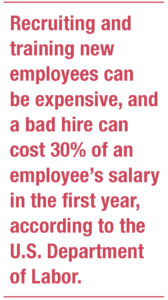The accelerating pace of the modern business environment imposes ongoing technology and innovation demands that invariably require skilled employees. Yet it’s no secret that enterprises have struggled to recruit and retain skilled employees in recent years, creating the current technology skills gap. However, in the economic uncertainty since the pandemic, we have seen an increase in boomerang employees who return to a previous employer after leaving.
Nearly one in five employees who resigned during the pandemic have already returned to their previous roles, according to a recent survey 1 of 4,000 workers in six countries by UKG, a provider of HR, payroll, and workforce management solutions. The survey showed that 41% who left their jobs would consider returning if it were an option. And 41% of respondents also admitted that they only considered leaving for less than one month and, in retrospect, they quit their positions too soon.
At the same time, 60% of managers said they believed that employees made the wrong decision by leaving their jobs, and nearly three in four managers (72%) said they felt those departed employees would consider returning within the year. Upon reflection, almost two-thirds of respondents (62%) decided that their prior job was, in fact, better than the one they left for. The main reasons why they regretted leaving included missing their co-workers (38%), their familiarity with their job roles (31%), the customers they served (22%), their payroll compensation (19%), and their prior work-life balance (16%).
There was a disconnect between boomerang employees who departed and their managers. One-fourth of employees conceded that they never mentioned their job frustrations to their managers before taking a new job. On the other hand, three-fourths of managers said their companies had supported their attempts to retain top talent, but less than half of employees (48%) felt that their managers had made any efforts to keep them on staff.
Why Boomerang Employees?
Returning boomerang employees bring much value to their organizations beyond that of a qualified new employee. In addition to their experience, insights, and ability to execute, their prior history with the company can help reduce workforce friction because they are already a proven cultural fit. Boomerangs can have a measurable impact on efficiency for onboarding, training, and overall team performance.
Recruiting and training new employees can be expensive, and a bad hire can cost 30% of an employee’s salary in the first year, according to the U.S. Department of Labor. New employees need time to acclimate to the new company’s systems and processes while learning their new responsibilities. With boomerang employees, those costs are drastically reduced. For example, there’s no need to engage a recruiter or spend as much on training because the employee is already familiar with the company, its processes, and its tools. Research by recruiting agency Spencer James Group indicates that the average Fortune 500 company can save $12 million annually by pursuing former employees instead of new hires. Depending on seniority and salary, the cost savings can be around $20,000 per rehired employee, according to Recruiter.com. 2
However, there is significant value beyond the skills boomerangs retain from the original organization – namely, the skills they have learned outside of it. Employees may move to a company in a similar space or even a competitor when leaving their companies. In their time away from the original company, they can develop a network outside the organization’s traditional orbit, including new colleagues, collaborators, and clients.
Employees bring these relationships when they boomerang, leading to a pipeline of potential new business and talent. Moreover, the insights employees can gain from working with other organizations are invaluable for their original company’s strategic plans when they return.
Recruiting boomerang employees is distinct from the traditional hiring process, which focuses on identifying candidates who possess the skills and knowledge for the job and are likely to be a cultural fit. The focus for boomerang hiring is pursuing individuals with a history of high performance who have already established that they are an excellent cultural fit. Recruitment should highlight the benefits of returning in terms of potential for growth, work environment, compensation, and other relevant incentives. The recruitment message should emphasize mutual positive experiences during the former employee’s time at the company and what has improved since they exited.
The assessment and selection stage for boomerang employees is also relatively more lenient. Because the company targets only individuals with a history of strong performance in their organization, this stage may focus more on how returning aligns someone with their career goals.
Rethinking the Hiring Process with Boomerangs
When people return to an organization, they are more likely to stay longer because they already understand the company’s culture and internal dynamics. Their presence can positively impact newer colleagues who view their return as proof that the grass may not always be greener somewhere else – the boomerang employee’s rebound reinforces how attractive the company has become since they left it.
Despite the many benefits of hiring boomerangs, there can also be some drawbacks for recruiters who fail to thoroughly analyze the prior employee’s tenure at the company. Some people may have left the organization under adverse circumstances or due to sour relationships with former employees. In other cases, employee personalities and behaviors may have changed since leaving the company. That is why a complete interview process should be conducted upfront to determine why the employee left the company in the first place and why they are now motivated to return.
Identifying and engaging boomerang hires requires a personalized and respectful approach. Not all former employees will be interested in returning, and it’s essential to accept their decision and maintain positive relationships regardless of their ultimate choice. Here are some key steps to help identify and engage boomerang employees on a strategic basis:
- Maintain an alumni network: The network can include employees from various levels and departments, leveraging platforms like LinkedIn to keep in touch. Regular touchpoints like newsletters and alumni events provide ideal opportunities to re-engage when it makes sense for both parties.
- Track departing employees and maintain a database: It’s essential to understand why employees leave in the first place, especially if the company is interested in re-engaging. Keeping records that allow recruiters and hiring managers to filter candidates by these metrics can enable a more refined search. Exit interviews and surveys can generate powerful insights in this area.
- Specialized job postings: When posting job openings, it can be beneficial to earmark specific niche roles for priority application among the alumni network, tapping not only direct alumni but also their networks. Encouraging former employees to refer potential candidates can be an efficient way of sourcing qualified candidates with an excellent cultural fit and serving as a mechanism to maintain a relationship with a valued former colleague.

Most companies usually seek to fill roles with outside talent or internal hires rather than engaging an alumni network for a potential boomerang hire. However, in the modern workforce, the average worker can be expected to change jobs every few years. At the same time, net new hires can be a gamble, considering the level of investment it takes to onboard someone fully. In this era of remote work and high churn rates, companies need to rethink their approach to the recruitment and hiring process to be more targeted and forward-looking. Microsoft’s IT Skills and Salary Report 3 found that 65% of hiring managers have trouble finding qualified talent, and 75% say workloads have become challenging.
Each case is unique, but HR outreach to hire more boomerang employees makes strong financial sense. Unlike new hires, these returning workers are already trained, so onboarding and training costs are essentially eliminated. They also bring the vibrancy of new ideas and strategies they picked up while working in other organizations. And those who return are more likely to stay with the company for longer since they already know what they are getting into.
Organizations should view high performers who leave the company as part of their extended network. Hiring back boomerangs is an effective strategy to source candidates who can bring the most value to the company with minimal friction. Establishing this kind of network pays back over time, as valued employees remain part of the organization’s community even after departing, especially when they return.
Endnotes



